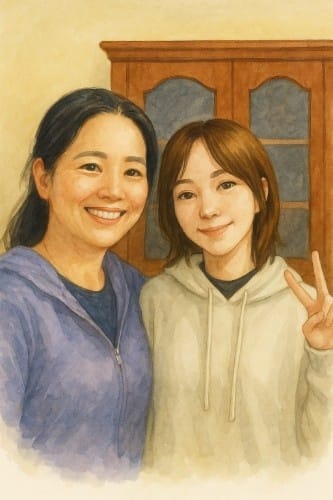Growing Isn’t Just for Kids

This past January, after returning from a visit to my daughter Baoqi in Taiwan, I had a strong urge to reset our home. For years, my husband and I had been fully immersed in supporting our kids through high school and the intense college application process. Now that both of them are stepping into new chapters of their lives, I finally felt ready to shift my focus back to myself—and to the space we live in.
One of the first things I decided to do was take down the old bookshelf that had been crammed with the kids’ textbooks and replace it with a beautiful and functional wall unit. I wanted to breathe new order and energy into our home.
At first, I explored having a built-in unit custom-made. I contacted several companies and reviewed lots of design samples, but the quotes were either outrageously high or the materials just didn’t feel right. Then, as I was browsing online, I stumbled upon a hardwood cabinet set made in China. The design was elegant, the wood rich and solid, and it perfectly matched my taste. Even though the seller was overseas, the price was reasonable, so I placed an order and began what would turn out to be a three-month wait.
In mid-April, the cabinet finally arrived in the U.S. I was thrilled. This wasn’t some lightweight, flat-pack IKEA furniture—it was real hardwood with a beautiful finish and substantial weight. Since my husband was tied up with work at the observatory, I decided to take on the assembly myself.
What I didn’t expect was how overwhelming the process would be. The parts came with no detailed instructions, and none of the wooden panels were labeled. I reached out to the seller and received only a sparse PDF guide. I realized that in China, these cabinets are probably meant to be assembled by professionals, not DIYers like here in the U.S. Still, I told myself: “Come on, I’m not going to let a piece of furniture defeat me!”
Over the next few days, I pieced it together like a giant puzzle, figuring out the structure as I went. It was tough, but every time a panel clicked into place, I felt a quiet satisfaction. In the final stages—when the structure was too heavy for me to lift alone—I enlisted the help of my husband and my son Baolin. Today was the last step: installing the four cabinet doors on top. Baoqi helped me steady them, and together we completed the project.
Since she’s been back from Taiwan, Baoqi has made a point of speaking to me in Chinese. Ironically, I often find myself slipping back into English. Watching her use Chinese so naturally fills me with joy. When she and her brother were young, I had to cut short their Chinese lessons for practical reasons, and I’ve always carried a bit of regret over that. I hoped that one day, they’d come to the language on their own terms.
And she has. Thanks to her outstanding academic record, Baoqi received a U.S. national scholarship to study Chinese intensively in Taiwan for a year. Her language skills improved rapidly, but more importantly, she began to understand the wisdom and culture behind the words. Learning Chinese was no longer “just something Mom wants”—it became her own meaningful choice. I couldn’t be more grateful. I hope Baolin will have a similar opportunity. If the two of them can intern in China next summer, they could support each other while deepening their connection with the language in an authentic context. I’ve always believed that language is more than a tool—it’s a bridge to culture and identity.
While we were finishing the cabinet, Baoqi and I began talking about relationships. She said she really hoped to build a stable partnership and eventually a loving, secure marriage. Many of her classmates come from complicated family situations, she told me, and it’s made her appreciate the importance of emotional stability even more.
Then she surprised me with a question:
“Mom, you’re always gentle with us—but sometimes you seem a little tough on Dad. Why is that?”
I smiled. “Well,” I said, “your dad has a strong personality. After living with him for so long, I’ve had to learn how to be a little tougher in return. In any relationship, there’s always a balance to strike. If I were too soft all the time, and he never adjusted, I’d end up feeling stifled. Our arguments come from caring about this home—we just express it differently.”
I told her that she and her brother take after me and my side of the family—gentle yet steady. You don’t need to be forceful to be strong. True wisdom, I said, is knowing how to stand your ground while staying kind and open. The most precious thing between people is finding a rhythm where both can grow and support each other.
Now that the cabinet is up, the space feels refreshed—and so does life. But what moved me even more were these heartfelt conversations with Baoqi. They reminded me of something important:
Growth isn’t just something kids go through. It belongs to us parents, too. It’s a journey of letting go, listening deeply, and learning to grow alongside our children.

